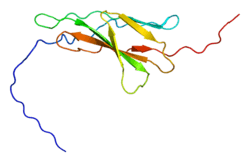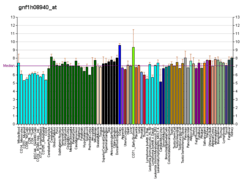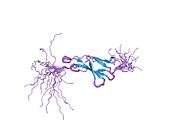References
- 1 2 3 GRCh38: Ensembl release 89: ENSG00000113805 - Ensembl, May 2017
- 1 2 3 GRCm38: Ensembl release 89: ENSMUSG00000030075 - Ensembl, May 2017
- ↑ "Human PubMed Reference:".
- ↑ "Mouse PubMed Reference:".
- ↑ Mock BA, Connelly MA, McBride OW, Kozak CA, Marcu KB (Feb 1997). "Plasmacytoma-associated neuronal glycoprotein, Pang, maps to mouse chromosome 6 and human chromosome 3". Genomics. 34 (2): 226–8. doi:10.1006/geno.1996.0271. PMID 8661054.
- ↑ Yoshihara Y, Kawasaki M, Tamada A, Nagata S, Kagamiyama H, Mori K (Mar 1996). "Overlapping and differential expression of BIG-2, BIG-1, TAG-1, and F3: four members of an axon-associated cell adhesion molecule subgroup of the immunoglobulin superfamily". J Neurobiol. 28 (1): 51–69. doi:10.1002/neu.480280106. PMID 8586965.
- ↑ "Entrez Gene: CNTN3 contactin 3 (plasmacytoma associated)".
Further reading
- Muzny DM, Scherer SE, Kaul R, et al. (2006). "The DNA sequence, annotation and analysis of human chromosome 3". Nature. 440 (7088): 1194–8. doi:10.1038/nature04728. PMID 16641997.
- Liu T, Qian WJ, Gritsenko MA, et al. (2006). "Human plasma N-glycoproteome analysis by immunoaffinity subtraction, hydrazide chemistry, and mass spectrometry". J. Proteome Res. 4 (6): 2070–80. doi:10.1021/pr0502065. PMC 1850943. PMID 16335952.
- Ota T, Suzuki Y, Nishikawa T, et al. (2004). "Complete sequencing and characterization of 21,243 full-length human cDNAs". Nat. Genet. 36 (1): 40–5. doi:10.1038/ng1285. PMID 14702039.
- Kamei Y, Takeda Y, Teramoto K, et al. (2001). "Human NB-2 of the contactin subgroup molecules: chromosomal localization of the gene (CNTN5) and distinct expression pattern from other subgroup members". Genomics. 69 (1): 113–9. doi:10.1006/geno.2000.6310. PMID 11013081.
- Nagase T, Kikuno R, Ishikawa K, et al. (2000). "Prediction of the coding sequences of unidentified human genes. XVII. The complete sequences of 100 new cDNA clones from brain which code for large proteins in vitro". DNA Res. 7 (2): 143–50. doi:10.1093/dnares/7.2.143. PMID 10819331.
- Connelly MA, Grady RC, Mushinski JF, Marcu KB (1994). "PANG, a gene encoding a neuronal glycoprotein, is ectopically activated by intracisternal A-type particle long terminal repeats in murine plasmacytomas". Proc. Natl. Acad. Sci. U.S.A. 91 (4): 1337–41. doi:10.1073/pnas.91.4.1337. PMC 43153. PMID 8108413.
PDB gallery |
|---|
1wj3: Solution structure of the fourth fn3 domain of KIAA1496 protein |






